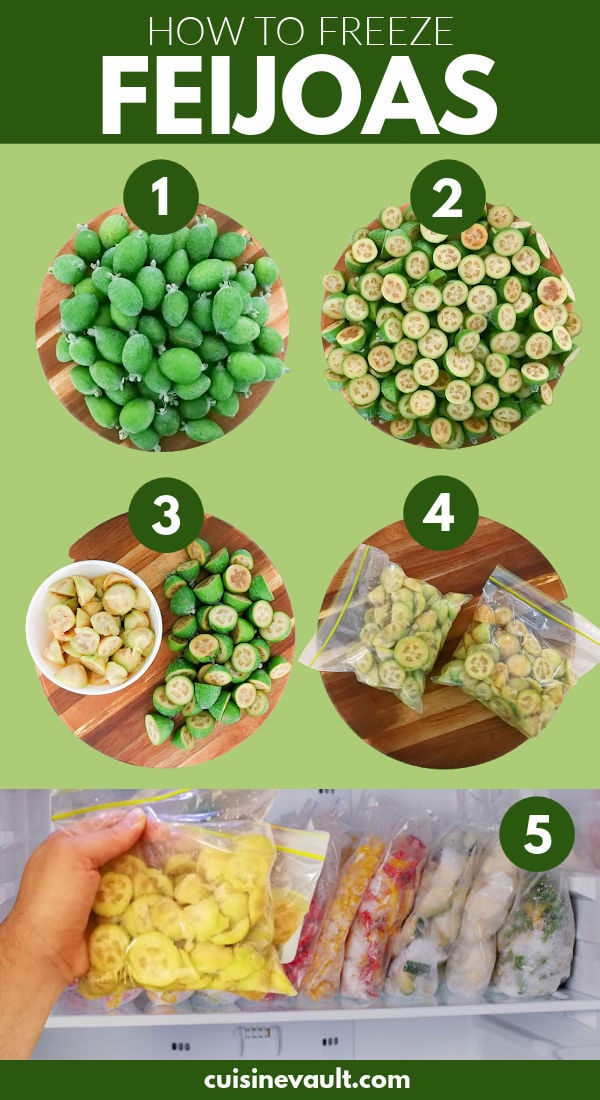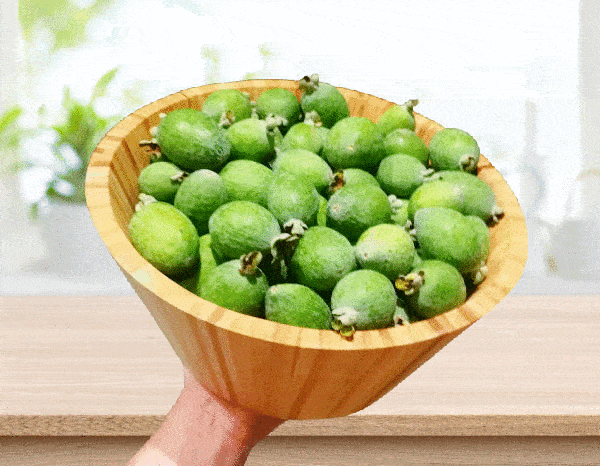Feijoa trees can produce a huge amount of fruit within a few weeks. If you’ve got one in the backyard and need a break from eating them, try freezing feijoas so that you've got some in the off-season.
How do I freeze feijoas?
Follow these steps if you want to get feijoa pulp any time of year for adding to smoothies, fritters, crumbles, and more.
- Using a chopping board and sharp knife slice the fresh feijoas in half.
- Scoop out the flesh with a spoon and place in a bowl. Discard the skins.
- Transfer the flesh to zip lock bags in portion-controlled quantities. We recommend freezing one cup batches.
- Label with name and current date for easy reference.
- Place the bags of feijoa at the back of the freezer to avoid temperature fluctuations.
If feijoas are stored in an appropriate airtight container, the flesh should last up to 12 months before starting to lose quality.
 How to thaw feijoas
How to thaw feijoas
Feijoas can be defrosted in the refrigerator and you should allow 5-6 hours for one pound of fruit that is a single block. Feijoas that have been pre-frozen individually will be ready to use much quicker. Thaw time will increase to 6-8 hours if the fruit has been stewed with sugar first.
For faster thawing, run feijoas under cold water at room temperature or microwave the fruit and use immediately.
Tips for freezing
- Freeze feijoas as soon as they are picked from the tree to lock in the nutritional content and flavor.
- If you enjoy incorporating feijoa into juices and smoothies, then blend the fruit and scoop into ice cube trays before freezing. Once frozen, pop the cubes into a suitably sized container and keep them in the freezer until you're thirsty.
- When adding feijoas to freezer-proof bags, force out all the air before sealing.
How to freeze feijoas without clumping
To help keep the fruit free-flowing, place a single layer of feijoa pulp on a baking tray and freeze for one hour before transferring to a freezer bag or suitable container.
 How do I stop feijoas turning brown?
How do I stop feijoas turning brown?
To stop feijoas from turning brown during the freezing process it is best to squeeze some lemon juice over the fruit. You can also add a shake of tartaric acid or citric acid and combine it with the pulp but this will add some extra tartness.
Alternatively, stew the fruit with sugar and a splash of water until just cooked then allow to cool before freezing. We recommend adding one cup of sugar for every four cups of feijoa flesh.
If it's likely you're going to cook the feijoas or add to recipes like smoothies or muffins once they are defrosted then you don't need to worry about them turning brown.
Can I freeze whole feijoas?
Feijoas can be frozen with their skin on but keep in mind that you may still need to peel them when it's time to use them. The secret is to remove the skins with a potato peeler while they are still frozen. Otherwise, they turn mushy and your job becomes a little harder.
Leaving the skins on will also use up roughly double the space in the freezer. If you don’t have a large chest freezer then you’re best to remove the skins first.
Uses for frozen feijoas
Once feijoas have been thawed, they can be used in most recipes that call for the fresh fruit. They’re excellent added to pies, crumbles, fritters, smoothies, juices, ice cream, sorbet, and baked goods. The flesh will lose some of its color so if you want to make a fruit salad then it won’t look as good as the fresh flesh.
Are feijoa skins edible?
Although most people discard the feijoa skin, it is perfectly edible and contains higher levels of vitamin C and dietary fiber than the pulp. The skin isn’t tough, but it is bitter in comparison to the sweet insides. Some people enjoy the balance of sweet and bitter.
Summing up
If you have a feijoa tree in the back yard and it's laden with fruit or you’ve ended up with too many in the kitchen, you’re best to freeze them. The fruit doesn’t last long at room temperature and it’s nice to have a supply of these fruits throughout the year.
The quickest, easiest option for freezing feijoas is to cut them in half, scoop out the flesh, and freeze one-cup portions in freezer bags. As with any food, it’s good practice to label the fruit to avoid any confusion in 6 months.

Leave a Reply